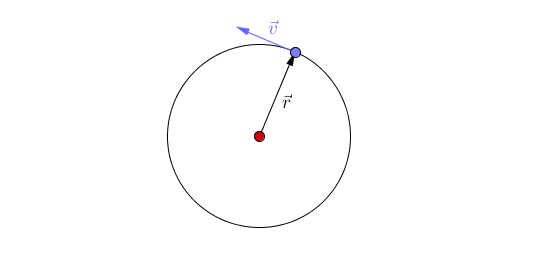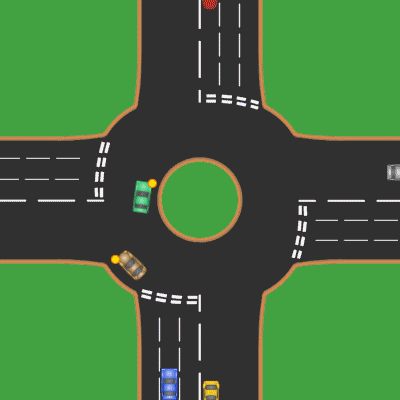Acceleration
Contents
Key Stage 3
Meaning
Acceleration is an increase in speed.
About Acceleration
- The opposite of acceleration is deceleration which is to slow down.
- Acceleration happens when an object experiences Unbalanced Forces.
Acceleration Equation
\[a = {\tfrac{v-u}{t}} \] Where:
- a = acceleration
- v = final speed
- u = initial speed
- t = time
Example Calculations
| A person starts at rest and accelerates to a speed of 8m/s in 0.8 seconds. Calculate the acceleration of the person. | A racing car travels comes around a corner at a speed of 20m/s and in 1.5 seconds accelerates to a speed of 80m/s. Calculate the acceleration of the racing car. |
|
final speed = 8m/s initial speed = 0m/s time = 0.8s \(a = {\frac{v-u}{t}} \) \(a = {\frac{8-0}{0.8}} \) \(a = {\frac{8}{0.8}} \) \(a = 10m/s/s \) |
final speed = 80m/s initial speed = 20m/s time = 1.5s \(a = {\frac{v-u}{t}} \) \(a = {\frac{80-20}{1.5}} \) \(a = {\frac{60}{1.5}} \) \(a = 40m/s/s \) |
| A horse begins trotting at 3.0m/s and accelerates to canter at 11m/s in 2.0 seconds. Calculate the acceleration of the horse. | A space probe is travelling at 18,000m/s and uses a thruster for 250 seconds to slow down to 6,000m/s. Calculate the acceleration of the space probe. |
|
final speed = 11m/s initial speed = 3.0m/s time = 2.0s \(a = {\frac{v-u}{t}} \) \(a = {\frac{11-3.0}{2.0}} \) \(a = {\frac{8.0}{2.0}} \) \(a = 4m/s/s \) |
final speed = 18,000m/s initial speed = 6,000m/s time = 250s \(a = {\frac{v-u}{t}} \) \(a = {\frac{6,000-18,000}{250}} \) \(a = {\frac{-12,000}{250}} \) \(a = -48m/s/s \) |
Key Stage 4
Meaning
Acceleration is a vector quantity that describes a change in velocity.
About Acceleration
- Acceleration is a vector because it has a magnitude and direction.
- The SI Units of acceleration and metres per second per second (m/s/s).
Acceleration may refer to:
- Increasing speed - The magnitude of the velocity increases.
- Decreasing speed - The magnitude of the velocity decreases, also known as deceleration.
- Changing direction - The magnitude of the velocity remains constant (constant speed) but the object changes direction of travel.
- Newton's First Law indicates that acceleration occurs due to unbalanced forces on an object:
An object in motion will tend to stay in motion and an object at rest will tend to stay at rest unless an unbalanced force acts upon it.
Examples
| This animation shows a linear acceleration as the objects roll down the slope. | This animation shows acceleration due to a changing direction. |
| In this animation there is linear acceleration and deceleration as the cars change speed as well as an acceleration due to changing direction.
The passengers notice this acceleration because it feels as if a force is acting on them:
|
Equation
Acceleration, Velocity and time
NB: You must remember this equation.
This equation applies to linear acceleration but not to a change in direction.
\(a = {\frac{\Delta v}{t}} \)
Where\[a\] = Acceleration of the object.
\(\Delta v\) = Change in magnitude of the velocity.
\(t\)= Time taken for the change in velocity.
Example Calculations
Calculating Acceleration
| A person starts at rest and accelerates to a speed of 7.8m/s in 0.64 seconds. Calculate the acceleration of the person correct to two significant figures. | A racing car travels comes around a corner at a speed of 25m/s and in 1.4 seconds accelerates to a speed of 73m/s. Calculate the acceleration of the racing car correct to two significant figures. |
| 1. State the known quantities
\(\Delta v\) = 7.8 - 0 = 7.8m/s time = 0.64s |
1. State the known quantities
\(\Delta v\) = 73 - 25 = 48m/s time = 1.5s |
| 2. Substitute the numbers into the equation and solve.
\(a = {\frac{\Delta v}{t}} \) \(a = {\frac{7.8}{0.64}} \) \(a = 12.1875m/s/s \) \(a \approx 12m/s/s\) |
2. Substitute the numbers into the equation and solve.
\(a = {\frac{\Delta v}{t}} \) \(a = {\frac{48}{1.5}} \) \(a = 32m/s/s \) |
| A horse begins trotting at 3.2m/s and accelerates to canter at 11m/s in 1.8 seconds. Calculate the acceleration of the horse correct to two significant figures. | A space probe is travelling at 18,100m/s and uses a thruster for 4.25 minutes to slow down to 6,200m/s. Calculate the acceleration of the space probe correct to two significant figures. |
| 1. State the known quantities
\(\Delta v\) = 11 - 3.2 = 7.8m/s time = 1.8s |
1. State the known quantities
\(\Delta v\) = 6,200 - 18,100 = -11900m/s time = 4.25min = 255s |
| 2. Substitute the numbers into the equation and solve.
\(a = {\frac{\Delta v}{t}} \) \(a = {\frac{7.8}{1.8}} \) \(a = 4.333m/s/s \) \(a \approx 4.3m/s/s\) |
2. Substitute the numbers into the equation and solve.
\(a = {\frac{\Delta v}{t}} \) \(a = {\frac{-11900}{255}} \) \(a = -46.67m/s/s \) \(a \approx -47m/s/s\) |
Calculating Change in Velocity
| A car begins from rest and accelerates at a rate of 4.5m/s/s for 23 seconds. Calculate the change in velocity of the car correct to two significant figures. | A person on The Moon drops a ball vertically. The acceleration due to gravity on The Moon is 1.6m/s/s. Calculate the change in velocity of the ball after 5.3seconds, correct to two significant figures. |
| 1. State the known quantities
a = 4.5m/s/s t = 23s |
1. State the known quantities
a = 1.6m/s/s t = 5.3s |
| 2. Substitute the numbers and evaluate.
\(a = {\frac{\Delta v}{t}} \) \(4.5 = {\frac{\Delta v}{23}} \) |
2. Substitute the numbers and evaluate.
\(a = {\frac{\Delta v}{t}} \) \(1.6 = {\frac{\Delta v}{5.3}} \) |
| 3. Rearrange the equation and solve.
\(\Delta v = 4.5 \times 23\) \(\Delta v = 103.5m/s\) \(\Delta v \approx 100m/s\) |
3. Rearrange the equation and solve.
\(\Delta v = 1.6 \times 5.3\) \(\Delta v = 8.48m/s\) \(\Delta v \approx 8.5m/s\) |


